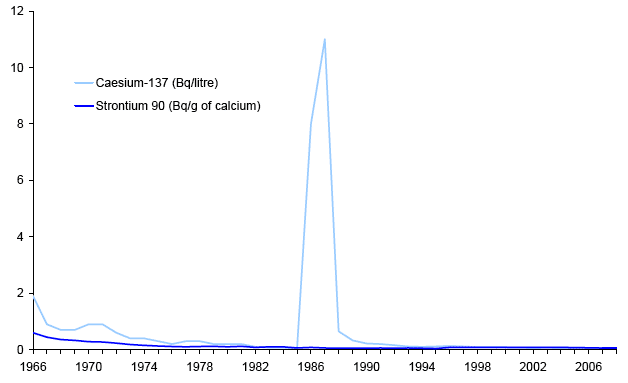Key Scottish Environment Statistics 2009
Annual publication containing summary of key statistics on environmental trends in Scotland
Radioactivity
Activity Concentrations in Milk: 1966-2008 4
Activity concentrations

Activity concentrations in milk
1966 |
1975 |
1987 |
2000 |
2007 |
2008 |
|
|---|---|---|---|---|---|---|
Caesium 137 (Bq/litre) |
1.90 |
0.30 |
11.00 |
<0.078 |
<0.050 |
<0.051 |
Strontium 90 (Bq/gram of calcium) |
0.60 |
0.13 |
0.06 |
<0.083 |
<0.057 |
<0.054 |
Exposures to ionising radiation from radioactive substances can have an impact on human health. For this reason a number of foodstuffs are monitored each year to assess that the public has been adequately protected from ionising radiation.
One such foodstuff which is widely consumed is cows' milk, which can provide a valuable indicator of changes over time. From 1966 until 1980, there were gradual falls in the concentrations of caesium-137 ( 137Cs) and strontium-90 ( 90Sr) until the concentration was so low it was difficult to detect. This reflects a decline in atmospheric radioactive fall-out, following the ban on above-ground nuclear weapons testing under the 1963 Partial Test Ban Treaty between the UK, USA and former USSR.
Following the Chernobyl reactor incident in 1986, concentrations of 137Cs in milk peaked in 1987 and then began to fall again and are now below pre-Chernobyl levels. 5 However, even at its peak the 137Cs concentration in milk was still below the Community Food Intervention Levels, defined by Euratom Regulations EC/3954/87 and EC/2218/89, which were derived to ensure the protection of the public. Even at its peak concentration following the Chernobyl accident the levels of 137Cs in milk were around 100 times lower than the intervention level.
There is a problem
Thanks for your feedback